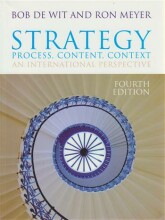Toegevoegd aan
18 important questions on Toegevoegd aan
What is meant with the institutionalization of cognitive space?
What are the most commonly recognized organization theories? (3 paradigms)
1 Functionalist - managerialist: objective reality which includes organizational characteristics such as structure and communication (it deals with the more traditional frameworks, like structure).
2 Radical-views, influenced bij Marx: analysis at the employee level with special attention to subordinates, attention to relations of power (concern at individual level: what would happen with employees in the industrial organization).
3 Postmodern: partly drwas on radical ideas and also on hermeneutic tradition, emphasizes perceptions/interpretations/enactments by actors (the use of language/demographics/gender etc., and how this influence social interaction and people).
What are the 4 organization theories? (this stems from the broader society/sociology)
1 Social constructionism
2 Diverse identities/racioethnicity and gender theories
3 Social identity theory (SIT)
4 Organization demography
-> This are theories of the postmodern paradigm
- Higher grades + faster learning
- Never study anything twice
- 100% sure, 100% understanding
According to social constructionism ideas are rooted in critical theory, beliefs include (3)?
2 People create meaning via language and other symbols
3 Language is:
A Forming/performing/constructing (rather than representing reality) it serves as a symbol
B A social process-sense-making (Weick)
C Process for constructing includes discourses (Burr), accounting (Harre) and enactment (Weick)
->Language is communicated very strongly is the mission statement of the organisation, it is as a symbol.
What 6 things are socially constructed in organizations?
2 Power relations: lines of communication, chains of command, participation
3 Stories and myths: represent the legitimate power relations, shared construction, symbols
4 Stifling (onderdrukken) of conflict: disables people in promoting their views/interests/creativity
5 Production of knowledge: who, what, why, how, when?
6 Identity: people have shifting identities interrelating with contextual and other factors.
Summarize the organization therory 'social constructionism':
Another organization theory is the 'diverse identities in organizations', what is the controlling idea of this theory?
What is diversity (Nkomo & Stewart)?
According to Cox & Blake's multicultural model there are 3 types of organizations, which 3?
2 Pluralism (heterogenous, but imbalance in responsible roles/power sharing
3 Multicultural (integration of non-dominant members and their ideas)
> The more diversity the richer the organization (for important decisions)
Summarize the diversity research in organization theories:
What is the controlling idea of re-writing gender into organizational theory?
Summarize postmodern and critical theories of racioethnicity and gender?
What examines group demographics?
What is the focus of relational demography?
Summarize the demography research:
Describe the organization theory: the social identity theory (SIT)?
SIT is a social psychology cognitieve theory which holds that individuals tend to classify themselves and others into social categories and that these classifications have a significant effect on human interaction.
> How we categorize people. A process of organizing.
What do SIT theorist pose (stellen)? (3)
2 Identify the influence of two-way/reciprocal processes between organizations/workgroup members
3 Address more fully the notion that members of any given social group vary.
Summarize the social identity theorie:
The question on the page originate from the summary of the following study material:
- A unique study and practice tool
- Never study anything twice again
- Get the grades you hope for
- 100% sure, 100% understanding































